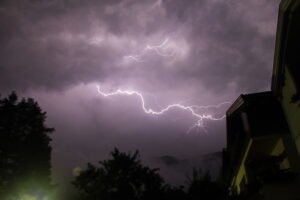
When you think of protecting valuable equipment in your home from a high voltage surge, what first comes to mind? If it’s just plugging your computer or your audio equipment into a power strip, then we’ve got news for you—that may not be enough.
These power strips are often sold to consumers as “surge protectors.” But in most cases, they’re basically just safer versions of antiquated octopus plugs and a way to extend the reach of the electrical equipment that needs to be plugged in. Yes, they’re useful, we won’t argue that. You should use them. But to rely on them to protect all the equipment in your home from a powerful voltage surge is folly.
What a Power Surge Can Really Do
Many power surges are small, and you often won’t notice them. Maybe a slight dimming of the lights. But these minor surges can add up over time with damage to equipment, so you can’t simply shrug these off. You may one day discover an important appliance isn’t working because of the cumulative effects of these small surges.
Then there are the big voltage surges. The ones from lightning strikes and downed power lines. These aren’t rare occurrences in Western New York, and even accidents at power plants can send a massive voltage surge through the lines to your house. These surges will do things to appliances connected to the electrical system such as ruining computers, refrigerators, ovens, and anything with complex circuitry in it. (Most modern appliances have electronic control boards in them to monitor and run their functions, and these are highly susceptible to surges.)
The Surge Protection Solution
You can have dual-layer protection for the electric system and appliances in your home. First, you have the plug-in power strips, which can help with minor surges by cutting off the power with a tripped breaker inside the strip. All computer appliances and precision equipment (this includes charging stations) should have a power strip.
Second is the installation of a whole-house surge protector. You must have a licensed Buffalo, NY electrical professional handle the installation, since the surge-protector is hard-wired into the electrical panel. These systems can handle up to a 40,000–70,000 amp surge by channeling the electrical overload down into the ground and bypassing the rest of the electrical system.
They won’t stop all the surge; a percentage may still pass through, but this is why you have the other line of defense with the power strips. Without the surge protector, the power strips wouldn’t have a chance—not only are they not strong enough, but they cannot react as fast to shut off the power as a whole-house surge protector.
Panel Upgrade
If you are considering whole-house surge protection installation, we also recommend you discuss a panel upgrade with our electricians. An older panel will have more trouble with voltage surges and some brands may even pose electrical hazards. If the panel is more than ten years old, let us examine it and we’ll help you decide if it’s time to put in a new electrical panel along with the surge protector.
Scherer Electric is Western New York’s Favorite Electrician! Schedule an appointment for whole-house surge protection.





